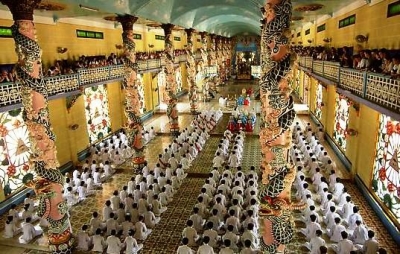Welcome to the world of Caodaism - an extraordinary indigenous religion that has captured the belief of over two million Vietnamese and the whimsy of everyone. Compared with other religions that have existed for millennia, this little-known religion is a visual and theological spectacular that could have been created only in the 20th century.
Overview
Dao Cao Dai (Caodaism in English) is the third largest religion in Viet Nam after Buddhism and Roman Catholicism. "Cao" means "high"; "Dai" means "palace". The word refers to the supreme palace where God reigns and also used as God's symbolic name. It originated in South Viet Nam in the early twenties and was officially inaugurated in 1926.
Caodaism is a religion which combines elements from many of the world's main religions, including Buddhism, Confucianism, Christianity, Hinduism, Islam, Judaism, Taoism, as well as Geniism. It is syncretistic in its doctrine, ritual practice, organizational structure, divinities and philosophy.

History behind.
The history of this religion underwent three important episodes of revelations. The first and second took place in 6th century before our era. During the first manifestation, God appeared under the three forms of Jewish leader in the Middle East, Buddha in India and Fou-Hi symbolizing the cult of humanity in China.
During the second manifestation, Buddhism reappeared in the form of Sakiamuni, Confucianism in that of Confucius, Christianity in that of Jesus-Christ, Taoism in that of Lao-Tseu and Islam in that of Mohamed.
As for the third manifestation, God has decided to reveal himself. This third manifestation based on Buddhism is often called "Ðại Ðạo Tam Kỳ Phổ Ðộ" (Great Way for the Third Universal Amnesty).)
Ngo Van Chieu, a civil servant of the Cochin china government began to receive messages from a spirit called Duc Cao Dai whom he believed to be God. After three years of studying and worshipping God, he shared his spiritual discoveries with others in Saigon. According to him, the alliance represented in Caodaism is God's third attempt to reveal his truth to humanity
At the end of the year At Suu (1926 CE), Cao Dai instructed a small group of mediums to found a new religion. One of the mediums, Le Van Trung was named by God to be acting Giao Tong (Pope).
With the unification of Viet Nam in 1975, the Caodaists' activities were restricted by the Communist government. Their Cuu Trung Dai (executive body) and Hiep Thien Dai (legislative body) were abolished and replaced with a Governing Council under the direct control of the government. Rituals and ceremonies continued without government interference.
Caodaist ethics are based on the Buddhist ideal of becoming a good person with a veneer of traditional Vietnamese taboos. Basic parameters such as avoiding killing, lying, opulent living, sensuality, stealing and eating meat that facilitate the soul's progress through the cycles of reincarnation.
The Caodaist consider vegetarianism is one of humane service as it doesn't involve harming other creatures during the process of their spiritual evolution. They follow several different vegetarian regimens; the least rigorous one is to eat vegetarian meals six days a month. However, priests are required to be full-time vegetarians.
Intensifying its distinct if somewhat contradictory nature, Caodaism simultaneously embraces monotheism and ancestor worship, proselytizing and praying for acceptance. And although they believe in only one God, Caodaists also recognize another principal deity--the Mother Goddess. A popular debate among the Caodaists focuses on which deity was the primary source of creation. The acknowledgment of both genders pervades the religion. The celibate clergy consists of both men and women. In a hierarchical structure similar to the Roman Catholic Church, female priests occupy all but the highest levels. However, when male and female clergy of the same rank work together, the men function as leaders.

With brightly robed priests and colorfully painted temples, Caodaist ceremonies are visually spectacular. They occur four times each day: 6 am, noon, 6 pm and midnight. Women enter the temple from the left, walk clockwise around the hall, and then congregate on the left side for worship. Conversely, men enter from the right and walk counter-clockwise. Both genders give offerings that range from the conventional incense, fruit and flowers to more unusual gifts of tea and alcohol.
The "Vatican" of Caodaism resides in Tay Ninh- a province 58 miles northwest of Saigon at an ornate cathedral called The Holy See. Built between 1933 and 1955, The Holy See has been described as a rococo extravaganza and the Disneyland of religious centers. The main religious centers currently have 7 to 8 million followers in Vietnam and about 30,000 members elsewhere, primarily in Asia, Australia, Canada, Europe and the United States.
The architectural combination of a church, pagoda and shopping center creates an idiosyncratic place of worship. Looking at the garish central hall, you will see that it has nine levels that represent the nine steps to heaven. The impressive colonnade consists of bright pink columns encircled by thick enameled dragons with stylized scales. The dome is filled with a low hanging blue globe decorated with the "divine eye" gazing down at the worshipers. Merely entering the building is a powerful experience. Do you know that this eye is the official symbol of the church, representative of the visions that created this religion?
With its historical and ceremonial pageantry, Caodaism is a fascinating addition to Vietnamese religious sects. In its effort to create an ideal religion by fusing secular and sacred philosophies of both East and West, Caodaism has succeeded in being unarguably unique.






































































































